Shannon Airport: Difference between revisions
Created page with "{{Infobox airport |county=Clare |picture=Shannon-airport-building-2008.jpg | IATA = SNN | ICAO = EINN |location =Shannon |latitude=52.701944 |longitude=-8.924722 }} '''Sha..." |
No edit summary |
||
| (One intermediate revision by the same user not shown) | |||
| Line 2: | Line 2: | ||
|county=Clare | |county=Clare | ||
|picture=Shannon-airport-building-2008.jpg | |picture=Shannon-airport-building-2008.jpg | ||
| IATA = SNN | |IATA = SNN | ||
| ICAO = EINN | |ICAO = EINN | ||
|type=International | |||
|location =[[Shannon]] | |location =[[Shannon]] | ||
|latitude=52.701944 | |latitude=52.701944 | ||
| Line 18: | Line 19: | ||
When World War II ended, the airport was ready to be used by the many new post-war commercial airlines of Europe and North America. On 16 September 1945 the first transatlantic proving flight, a Pan Am DC-4, landed at Shannon from New York City. On 24 October, the first scheduled commercial flight, an American Overseas Airlines DC-4, passed through Shannon Airport. | When World War II ended, the airport was ready to be used by the many new post-war commercial airlines of Europe and North America. On 16 September 1945 the first transatlantic proving flight, a Pan Am DC-4, landed at Shannon from New York City. On 24 October, the first scheduled commercial flight, an American Overseas Airlines DC-4, passed through Shannon Airport. | ||
[[File:Shannon Airport.jpg|thumb| | [[File:Aircraft, Shannon Airport, July 1997 (02).jpg|right|thumb|200px|Aircraft at Shannon Airport in 1997]] | ||
The number of international carriers rose sharply in succeeding years as Shannon became well known as the gateway between Europe and the Americas; limited aircraft range necessitated refuelling stops on many journeys. Shannon became the most convenient stopping point before and after a trip across the [[Atlantic Ocean|Atlantic]]. Additionally, during the Cold War, many transatlantic flights from the Soviet Union stopped here for refuelling, because Shannon was (and is today, though it no longer matters in this sense) the westernmost non-NATO airport on the European side of the Atlantic. | The number of international carriers rose sharply in succeeding years as Shannon became well known as the gateway between Europe and the Americas; limited aircraft range necessitated refuelling stops on many journeys. Shannon became the most convenient stopping point before and after a trip across the [[Atlantic Ocean|Atlantic]]. Additionally, during the Cold War, many transatlantic flights from the Soviet Union stopped here for refuelling, because Shannon was (and is today, though it no longer matters in this sense) the westernmost non-NATO airport on the European side of the Atlantic. | ||
Latest revision as of 18:32, 21 February 2020
| Shannon Airport | |
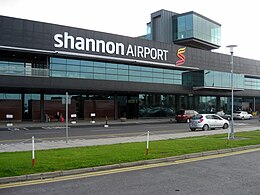 | |
|---|---|
| Code | IATA: SNN, ICAO: EINN |
| County | County Clare |
| International | |
| Location | Shannon 52°42’7"N, 8°55’29"W |
| Website | |
Shannon Airport is one of Ireland's three primary airports, along with Dublin and Cork. In 2016, around 1.75 million passengers passed through the airport,[1] making it the third busiest airport in the country after Dublin and Cork. Shannon Airport is in Shannon, County Clare, and mainly serves Limerick, Ennis, Galway and the south-west of Ireland.
History
Before 2010
In the late 1930s, transatlantic air traffic was dominated by flying boats, and a flying boat terminal was located at Foynes on the south side of the Shannon Estuary. However, it was realised that changing technology would require a permanent runway and airport.
In 1936, the Government of Ireland confirmed that it would develop a 1.2-sq. mile site at Rineanna for the country's first transatlantic airport. The land on which the airport was to be built was boggy, and on 8 October 1936 work began to drain the land. By 1942 a serviceable airport had been established and was named Shannon Airport. By 1945 the existing runways at Shannon were extended to allow transatlantic flights to land.
When World War II ended, the airport was ready to be used by the many new post-war commercial airlines of Europe and North America. On 16 September 1945 the first transatlantic proving flight, a Pan Am DC-4, landed at Shannon from New York City. On 24 October, the first scheduled commercial flight, an American Overseas Airlines DC-4, passed through Shannon Airport.
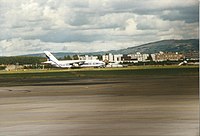
The number of international carriers rose sharply in succeeding years as Shannon became well known as the gateway between Europe and the Americas; limited aircraft range necessitated refuelling stops on many journeys. Shannon became the most convenient stopping point before and after a trip across the Atlantic. Additionally, during the Cold War, many transatlantic flights from the Soviet Union stopped here for refuelling, because Shannon was (and is today, though it no longer matters in this sense) the westernmost non-NATO airport on the European side of the Atlantic.
The longest runway in Ireland, at 10,495 ft, is located at Shannon. It was a designated landing site for the Space Shuttle.[2] On 4 July 2014, the "Bank of Ireland Runway Night Run" featured 1,200 people running along the runway to raise money for charity.[3]
Ryanair increased services and passenger numbers at the airport through 2008. In 2007, Shannon carried 3.2 million passengers. However, after a disagreement with the Dublin Airport Authority (DAA) in 2008, Ryanair announced that the number of based aircraft would reduce from 4 to 1 and 150 jobs would be lost. Services were cut by 75% and 32 Ryanair routes from the airport were reduced to 8.
CityJet launched a twice-daily route to Paris Charles de Gaulle Airport in 2008 when Aer Lingus closed its London Heathrow flights. The company based an Avro RJ85 at Shannon. More services were under consideration, including a route to London City Airport; however CityJet pulled out of Shannon in October 2009 after Aer Lingus reinstated its Heathrow flights.
2010-present
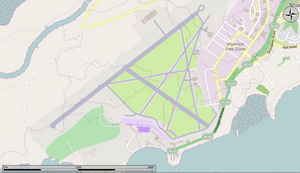
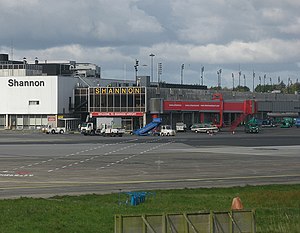
In December 2012, it was announced that Shannon Airport would separate from the Dublin Airport Authority, who still own Dublin and Cork airports. On 31 December 2012 at 11:59 pm, Shannon Airport became a publicly owned commercial airport and is now operated and run by the Shannon Airport Authority plc.
Traffic figures for June 2013 report an 8% increase on the previous year, the first time a traffic increase has been recorded in three years. On 21 March 2013, Ryanair announced a new twice-weekly route to Alicante, Spain to begin on 5 June for the summer months. That brought Shannon's total to 33 seasonal scheduled summer routes. In October 2013, United Airlines confirmed it will increase capacity by 88% on its Shannon-Chicago route for 2014. In late 2013, Aer Lingus announced 2 new routes to Málaga, Spain (two weekly) and to Bristol, UK (one daily). Ryanair also announced 8 new routes from Shannon to continental Europe. The new routes began from the start of April 2014, and a second Boeing 737-800 was based at Shannon to accommodate the extra 300,000 passengers a year it would bring in. The destinations announced were Berlin Schonefeld, Beauvais, Memmingen, Warsaw Modlin, Kraków, Nice, Faro, and Fuerteventura.
In late 2014, Aer Lingus Regional operator Stobart Air said that they would close down their Shannon base in early 2015. They returned in June 2015 operating 6 flights weekly Birmingham service followed by 6 flights weekly Edinburgh service. In late 2015, they announced a new CEO for Shannon, Matthew Thomas. Ryanair announced that it will be ending its Paris and Memmingen routes in late 2016, and it also reduced its Manchester and London Stansted routes. Ryanair is aiming for 720,000 passengers in Summer 2017 even though that they were close to 800,000 in Summer 2016. In October 2016, SAS announced a new route to Stockholm from August 1, 2017 to October 7, 2017. Shorty after that, Lufthansa announced 1 flight weekly service to Frankfurt running from April to October in 2017.
Duty-free
In 1947, the "Customs Free Airport Act" established Shannon as the world's first duty-free airport, a move promoted by Brendan O'Regan; although "duty-free" shopping is not applicable any more for flights within the European Union, EU-bound passengers can still buy goods, but have to pay the normal taxes.[4] Shannon became a model for other duty-free facilities worldwide.[4] For most goods, passengers can buy the same goods regardless of their destination: the only difference will be made in charging VAT at check-out. An exception to this are tobacco products, as all tobacco products sold in Ireland need to have an excise stamp, while this does not apply for "real" duty-free tobacco. As the prices for tobacco in Ireland are among the highest in the world, there is little or no demand for tobacco at Irish airports for EU flights.[5]
Transatlantic services to the US
In 1969, it was announced that a new government agency, Aer Rianta (now the Dublin Airport Authority), would be given responsibility for Shannon Airport. Passenger numbers at the airport reached 460,000 that year. With the increase in passengers and the introduction of the Boeing 747, it was decided that a new enlarged terminal was needed. The first commercial operation of a 747 took place in April 1971, while the new terminal officially opened in May that year. In 1974, a major increase in fuel prices had a dramatic effect on transit traffic.
During the 1990s, the airport began to struggle. The bilateral agreement with the United States was renegotiated, resulting in fewer planes being required to stop over in Shannon (see Shannon Stopover below). However, 1996 saw the beginning of Continental Airlines flying between Dublin, Shannon and Newark, New Jersey.
With the demise of the Soviet Union in the early 1990s, Aeroflot began to suffer, which was a big loss to the airport. Aeroflot had brought 250,000 passengers a year through Shannon.[6]
Shannon began to rebound in the late 1990s with the success of the Irish economy, the improving situation in Northern Ireland and an influx of American tourists. By the end of the decade Shannon had passenger numbers of 2.2 million and in the year 2000, a new £40 million terminal extension was opened.
Shannon continued to expand during the Celtic Tiger years with many services operated to the U.S. and Canada.
Shannon stopover
The first Air Services Agreement with the United States in 1945 only permitted flights to Shannon and only permitted Irish airlines to serve Boston, Chicago and New York. In 1971, the US Civil Aeronautics Board announced that unless US planes were allowed to operate into Dublin Airport they proposed to ban Aer Lingus from landing in New York. Eventually an agreement was reached which allowed one US carrier, TWA, to service Dublin Airport through Shannon.
In 1990, the US-Irish bilateral agreement was changed to allow Irish airlines to serve Los Angeles and additional US airlines to serve Dublin via Shannon. An amendment in 1993 allowed airlines to provide direct transatlantic services to Dublin, but 50% of transatlantic flights had to either originate or stop over in Shannon.
In 2005, an agreement was reached regarding a transitional period. Beginning in November 2006 and ending in April 2008, the agreement gradually eliminated restrictions on cargo services. For passenger service, it reduced the stopover requirement and allowed Irish airlines to serve three additional US destinations. Furthermore, it was agreed that at the end of this period, no restrictions would be placed on scheduled services between any airport in the one country to any airport in the other.
In 2007, the European Union and the USA announced that an agreement had been reached on an open skies aviation policy. The agreement came into effect from 30 March 2008. This effectively led to the complete abolition of the Shannon Stopover, although this would have happened under the 2005 agreement anyway.
Military stopover issue
Shannon Airport has a history of foreign military use. A large part of its business in recent years has been military stopovers, currently almost all American; however, the airport was also frequently used by the Soviet military until the 1990s, since Ireland, having a traditional policy of military neutrality, was not a member of NATO. There were some restrictions, such as being unarmed, carrying no arms, ammunition, or explosives, and that the flights in question did not form part of military exercises or operations. Shannon saw military transports throughout the Cold War and during the first Gulf War.
As of November 2008, approximately 1.2 million troops have passed through Shannon since the beginning of the Iraq War.[7] This has generated significant revenue for the airport and has offset the loss of flights from the end of the Shannon stopover and the general downturn in the global aviation industry.
In 2012–2013, the military flight contracts are held by Omni Air International, which uses Boeing 767 and 777 aircraft, [8] Sun Country Airlines, which uses 737-800 aircraft, and North American Airlines, which uses Boeing 757s.
In 2014, only Omni Air International operate troop transit flights, with an average of 1-2 flights per day
Facilities
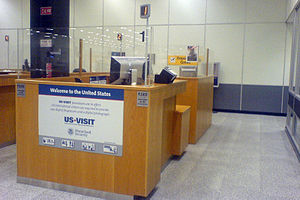
Overview
The current airport terminal was opened on 27 March 2000 by then Minister of Transport Mary O'Rourke. This facility has 40 check-in desks, 5 baggage carousels and 14 boarding gates (including 6 airbridges). There are nearly 20 aircraft parking stands. The car-parks can hold 4,200 cars.[9]
Much of the older landside section of the airport has been renovated with new 'Shannon Airport' branding. An airside area renovation and passenger separation project was completed in Summer 2010.[10]
Aer Rianta International, a subsidiary of the Dublin Airport Authority, has its head office on the grounds of Shannon Airport.[11] When Eirjet existed, its head office was located on the grounds of Shannon Airport.[12]
US Customs and Border Protection pre-clearance
In 1986 a United States border preclearance facility was opened at Shannon, eliminating the need to go through immigration on arrival in the United States.[13] In November 2008, it was announced that customs and agriculture inspections would be added, making Shannon the first airport in Europe to offer this service. To have these facilities put in place a two-storey, 75,000 sq. ft extension to the main terminal building has been constructed. The facility opened the morning of 5 August 2009.[13]
As of September 2016, Shannon Airport also is the first and only airport outside the US to offer US Customs and Border Protection to private aircraft.[14]
- British Airways flights to New York City
British Airways operates a daily (twice-daily until October 2016) business class-only flight from London City Airport to John F. Kennedy International Airport in New York with a stopover in Shannon. This allows them to take off from the short runway of City Airport, which is located in the London Docklands area and stop for fuel in Shannon. On the earlier and remaining flight BA1 passengers can use the stop to go through pre-clearance and arrive in New York without the need to go through immigration or customs. Until October 2012 both flights allowed pre-clearance in Shannon, but an earlier closure of the pre-clearance facility due to US CBP staff cutbacks meant passengers on the later flight BA3 had to pass immigration and customs at JFK.[15] The later flight was however cancelled altogether by October 2016.[16]
Statistics
| Year | Total passengers[17] |
Passengers change YoY % |
|---|---|---|
| 2005 | 3,302,046 | |
| 2006 | 3,639,046 | |
| 2007 | 3,620,623 | |
| 2008 | 3,169,529 | |
| 2009 | 2,794,563 | |
| 2010 | 1,755,885 | |
| 2011 | 1,625,453 | |
| 2012 | 1,394,781 | |
| 2013 | 1,440,034 | |
| 2014 | 1,639,315 | |
| 2015 | 1,714,872 | |
| 2016 | 1,749,367[1] |
Busiest routes
| Rank | Airport | Passengers Handled |
% Change 2015/16 | |
|---|---|---|---|---|
| 1 | London–Heathrow | 265,428 | ||
| 2 | London–Stansted | 239,094 | ||
| 3 | New York–JFK, United States | 135,295 | ||
| 4 | London–Gatwick | 111,804 | ||
| 5 | Boston, United States | 99,007 | ||
| 6 | Newark, United States | 95,946 | ||
| 7 | Manchester | 84,271 | ||
| 8 | Faro, Portugal | 58,709 | ||
| 9 | Málaga, Spain | 55,830 | ||
| 10 | Kraków, Poland | 39,185 | ||
| 11 | Philadelphia, United States | 39,170 | ||
| 12 | Lanzarote, Spain | 38,730 | ||
| 13 | Wrocław, Poland | 38,059 | ||
| 14 | Warsaw–Modlin, Poland | 36,414 | ||
| 15 | Berlin–Schönefeld, Germany | 34,132 | ||
| Source: Central Statistics Office[18] | ||||
Ground transportation
Road
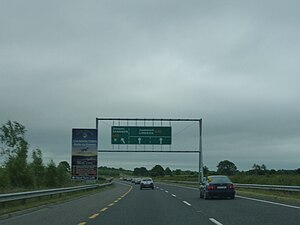
Shannon Airport is the end destination of the N19 national route, which connects to the N18/M18 Limerick–Ennis–Galway route. A dual-carriageway section of the N19 was finished in 2004, bypassing the town of Shannon, and a new interchange and dual carriageway north to Ennis were completed in 2007 on the N18 (M18). It is approximately 15 miles west of Limerick and around 53 miles from Galway to the south. Dublin is approximately 139 miles away and Cork is around 78 miles away.
Bus
Shannon Airport is served daily by 136 Bus Éireann services.[19]
Other
The airport is also served by local taxis. There is a taxi rank outside the arrivals entrance.
Car Hire
Car hire is available in the arrivals hall of the terminal building, with five car rental firms operating at the airport.[20] Private-hire coaches and buses are available from many operators such as Eirebus;[21] these need to be pre-booked and can transport passengers to any destination throughout Ireland.
Car Parking
Shannon Airport offers both short-term and long-term parking within the airport with over 5,000 spaces available. All car parks operate 24 hours and are regularly patrolled by Airport Police.
Rail Link
For many years a rail link to the airport (as a spur from the nearby Limerick–Ennis line) has been proposed,[22][23] but nothing has materialised. The nearest major stations (Ennis railway station and Limerick railway station) require bus or taxi to connect with. Sixmilebridge is the nearest station to the airport.
Environmental issues
As Shannon Airport has been build adjacent to the Shannon Estuary, it is likely to have problems with rising sea levels and high waters in the Shannon. The government is working on plans to protect both the airport and the town.[24]
References
- ↑ 1.0 1.1 "European Airport Traffic Trends". Anna.aero. http://www.anna.aero/european-airport-traffic-trends. Retrieved 28 January 2017.
- ↑ Worldwide Shuttle Landing Site information
- ↑ "Bank of Ireland Runway Night Run". Shannon Airport. 5 July 2014. http://www.shannonairport.ie/gns/about-us/BankOfIrelandRunwayNightRun.aspx. Retrieved 28 July 2014.
- ↑ 4.0 4.1 Chevalier, Michel (2012). Luxury Brand Management. Singapore: John Wiley & Sons. ISBN 978-1-118-17176-9.
- ↑ "International Cigarette Prices". http://www.cigaretteprices.net/. Retrieved August 23, 2016. "with an overview of international prices for a box of 20 Marlboro cigarettes"
- ↑ "Growth – Shannon recovers passenger throughput". IHS Jane's 360. http://www.janes.com/extract/jar2000/jar00255.html. Retrieved 15 January 2014.
- ↑ "Almost 200,000 troops use Shannon". Irishtimes.com. 6 November 2008. http://www.irishtimes.com/newspaper/ireland/2008/1106/1225893547102.html. Retrieved 3 October 2015.
- ↑ "The US Military’s International Airlift Contracts". Defense Industry Daily, LLC. http://www.defenseindustrydaily.com/the-us-militarys-international-airlift-contracts-05066/. Retrieved 3 October 2015.
- ↑ Shannon Airport Information
- ↑ Airport Facts
- ↑ "Contact Us." Aer Rianta International. Retrieved on 7 July 2010.
- ↑ "home." Eirjet. 1 July 2006. Retrieved on 15 September 2010.
- ↑ 13.0 13.1 airlinesanddestinations.com - Shannon Is First Euro Airport with Full U.S. Pre-Clearance 5 August 2009
- ↑ shannonairport.ie - US Preclearance for Private Aircraft retrieved 17 September 2016
- ↑ businesstraveller.com - BA003 New York service to lose US pre-clearance at Shannon 6 September 2012
- ↑ https://www.businesstraveller.com/business-travel/2016/08/31/british-airways-cancels-one-london-city-new-york-business-class-services/
- ↑ "Shannon Airport Traffic Figures". Shannon Airport. http://www.shannonairport.ie/gns/about-us/traffic-figures.aspx. Retrieved 17 May 2016.
- ↑ "Passenger Movement by Irish Airport, Direction, Foreign Airport and Month". Central Statistics Office. December 2016. http://www.cso.ie/px/pxeirestat/Statire/SelectVarVal/Define.asp?maintable=ctm01. Retrieved 25 March 2017.
- ↑ "Shannon Airport Information". https://www.irishcarrentals.com/carrentalshannonairport.php. Retrieved 29 February 2016.
- ↑ "Car Rental". http://www.shannonairport.ie/gns/Passengers/Go/car-rental.aspx. Retrieved 29 February 2016.
- ↑ http://www.eirebus.ie
- ↑ Deegan, Gordon. "Car Rental". Shannon Airport (Dublin). http://www.shannonairport.ie/gns/Passengers/Go/car-rental.aspx. Retrieved 29 February 2016.
- ↑ Woulfe, Jimmy. "Iarnród Éireann to look at feasibility of rail link to Shannon Airport". Irish Examiner. http://www.irishexaminer.com/archives/2006/0428/ireland/iarnrod-eireann-to-look-at-feasibility-of-rail-link-to-shannon-airport-1932.html. Retrieved 23 December 2013.
- ↑ Shannon Airport at risk of being 'swept away' as State could face €3.2bn flood clean-up bill
Outside links
| ("Wikimedia Commons" has material about Shannon Airport) |
